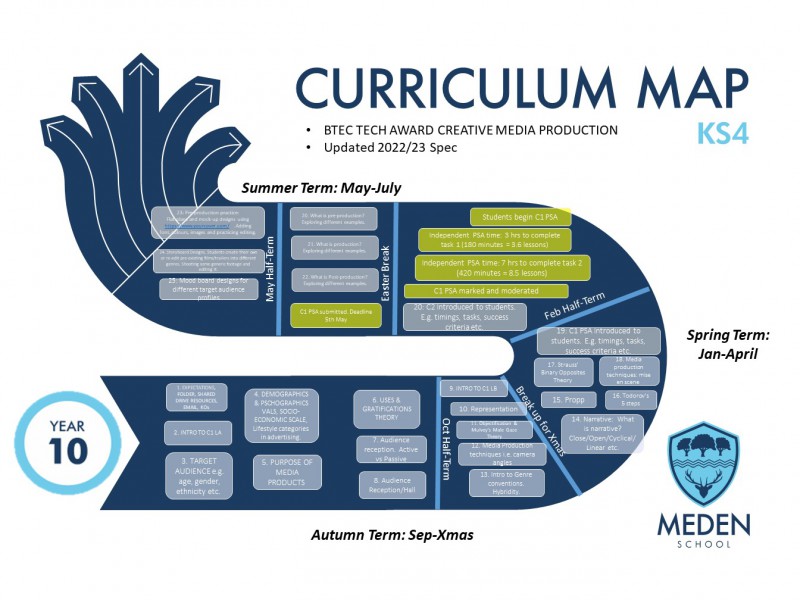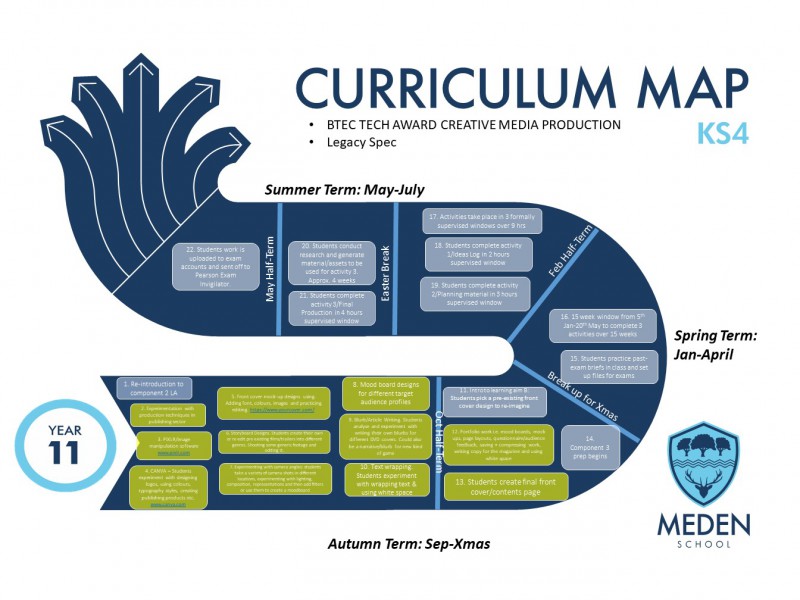KS4
Below is information about our media KS4 curriculum. Each drop down box contains the topics we cover. For more detail on the knowledge we teach, please click on each medium term plan. Our curriculum map shows the learning journey that our students embark upon.
In Year 10, students study the following topics:
Component 1 Topics
- LA: Purpose of Media Products
- LA: Identifying target audience/demographics
- LB: Genre conventions
- LB: Narrative theory
- LB: Representational analysis
- LB2: Production Techniques e.g. mise en scene
Component 2 Topics
- LA: What is pre-production?
- LA: Creating pre-production planning
- LB1/2: Experimenting with asset creation, mock ups, taking and manipulating photographs, writing copy, creating a product
- LC: Evaluating post-production processes
In Year11, students study the following BTEC Tech Award in Creative Media Production and study the following topics:
- LA1: Responding to a client brief
- LA2: Analysing requirements and generating ideas
- LB1: Develop planning materials
- LB2: Managing the production process
- LC1: Managing, combining and reviewing production process
- LC2: Production skills and techniques
- LC3: Combining and refining content
Click maps to enlarge.
Whole School Curriculum Intent for Media
Developing Character
- Students are encouraged to share ideas throughout Media lessons to build confidence in speaking out loud.
- Student independence is also promoted by encouraging students to research answers themselves before requesting teacher help.
- Students are reminded on a daily basis of outstanding ATL criteria in Media studies and what they need to do to achieve it. This is displayed on walls around the room to remind students of what their attitude and mentality needs to be in order to be successful.
- Lessons aim to develop empathy, tolerance and resilience through topic choices and debates regarding important historical, current and social issues in the media landscape.
- Throughout both KS4 and KS5 Media, students’ work is celebrated and shared with the class to develop and support students’ ambitions.
- Students’ good work is also rewarded through ATL points and achievement certificates in assemblies.
Developing Academic Aptitude
- Engaging students through topic choices, generating discussion through application to real life examples
- All lessons focus on developing students’ knowledge of key academic theories relating to representation, narrative, genre, audiences etc and developing key skills relating to the exam
- Both KS4 and KS5 lessons focus on recapping and embedding students’ knowledge and understanding through the use of weekly knowledge quizzes to ensure improvement in knowledge recall
- Regular assessments take place to monitor revision and examination skill. This especially takes place with KS5 students given the more academic nature of the course.
- For BTEC students, the course if more practical in nature and so regular KO quizzes take place to test students’ understanding.
- Student data is regularly analyzed through DAPA to ensure all students are achieving their full potential
- Students are regularly provided with opportunities to practice new skills within lesson and homework activities aim to embed knowledge and build on what students are learning in class.
Have both high levels of aspiration and high levels of support
- Lesson topics and individual lessons make links throughout the course to possible careers in the media industry such as journalism, media production, multimedia and television.
- Media studies is promoted as both a reputable and increasingly pertinent subject at both KS4 and A-level to provide students with a diverse range of subject opportunities.
- Work is differentiated throughout the curriculum to ensure ALL students are actively engaged and supported so they can access the course content.
- The language used in lesson is aspirational with regular use of tier 2 and tier 3 vocab and subject specific terminology.
- Students are regularly given projects and individual tasks to complete both as a group and individually so as to encourage student independence and initiative. This helps promote students’ wider skills outside of the classroom.
- LAPs and PP students are regularly monitored in lessons to ensure they can access the lesson and make progress i.e. seating plans, 1:1 support and intervention groups both during study and after school also help to ensure all students can maintain progress in the subject.
- Reading opportunities are provided for students within lesson to support literacy through the use of lollipop sticks, random name generators and teacher toolkit to ensure different students are also able to volunteer and not always the same one.
- Lessons also focus on growth mindset in lessons and the importance of student reflection on their own achievement. This is primarily done through the regular use of peer/self assessment and GPA (green pen action).
Ensure it is academically rigorous and it will engage and enthuse our children
- Regular communication takes places with other schools to aid with moderation of students’ coursework.
- This also takes place between exam boards e.g. AQA and Pearson to ensure coursework briefs are verified and in line with assessment objectives and exam board regulations.
- Students have to learn clear writing structure i.e. PEEL, to help develop students’ line of reasoning and essay writing skills.
- Students have to include a breadth and depth of knowledge in their written work, demonstrating not only a range of information but a clear understanding of different theories and perspectives.
- Students are set regular wider reading homework to engage and encourage interest in topic areas
- Tasks are revisited throughout the curriculum to ensure students understand important issues.
- Modelling and exposure to higher level examples used throughout the course, specifically from revision websites, AQA specimen material and also from marked papers of former students to help develop students’ understanding of how to gain marks in the exam.
Tailor its design to make it individual and personal to our children’s needs
- Students are supported in their writing throughout KS4 and KS5 through the use of paragraph templates to guide their writing.
- Students are encouraged to use PEE and PEEL structures, along sentence starters, model answers in order to develop their writing and ability to structure a coherent and cogent argument and line of reasoning.
- Scaffolds and support sheets are readily available in lessons and sentence starters are written on the window at the front of the room to support lower ability students.
- Challenge tasks present during every lesson to stretch and challenge the higher ability learners.
- Knowledge organizers have been created for both BTEC and A-level students to help condense learning.
- Lesson resources i.e. worksheets, KOs, ppts have been made readily available on the student shared drive along with exemplar work to help students access lesson material both in and outside of normal lesson time.
Promote and develop both cultural and social capital
- Lessons are linked to wider social and cultural topics that are not just solely relevant to the specification studied for the course. For example, students are encouraged to keep diaries of interesting adverts/media texts/stories they encounter and to discuss these in class to broaden their understanding of how the media impacts them on a daily basis.
- Lessons focus on promoting student interaction and collaboration with each other in every task and regularly share work and ideas and also work together in group tasks to create presentations, thus building a sense of team work and social capital.
- Further to this, students study a variety of topics and movements such as gender stereotyping in the media and the rise of third/fourth wave feminism, social-media campaigns like #metoo and #iftheygunnedmedown, the effect of globalisation, air brushing in the media, the rise of internet influencers and more in order to develop their awareness of how the media can connect people and manipulate at the same time.
- Students also analyse how the changing zeitgeist has affected the media landscape we live in, especially in how people are represented. For example, students discuss the changing representations of gender and sexuality, focusing in particular on how the media has shifted more towards a more liberal era, defined by gender equality.
- Students also explore how men are increasingly shown as more vulnerable and women as strong and empowered.
- Students are given opportunities to see how the media has reinforced a dominant heterosexual ideology on consumers in the past but this is now giving way to different sexualities represented in adverts, Tv shows and films.
- Topics in lessons focus on encouraging discussion about ethnicity, class, gender, age, disability, sexuality and encourage understanding and sensitivity to other cultures.


